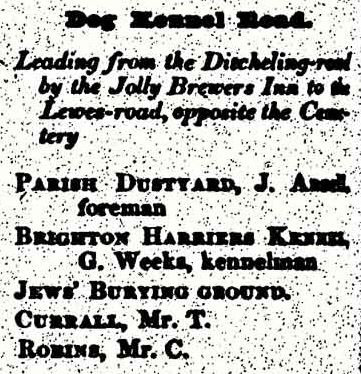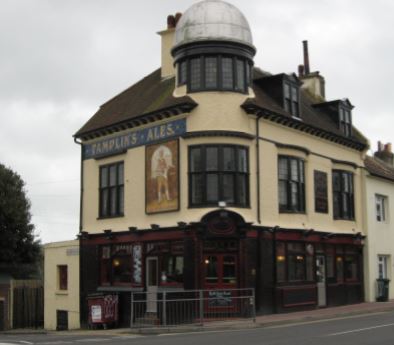Dog Kennel Road
Folthorps 1856 Directory confirms the location of Dog Kennel Road.
By 1869, it had become Hollingdean Road.
The upper part is now a section of Hollingdean Lane. The loop named Upper Hollingdean Road was a later addition.
Dog Kennel Road leads from the Ditchling Road by the Jolly Brewer Inn (i.e. Florence Place) to the Lewes Road opposite the cemetery. Note that in 1856, no homes were listed on this track at the north side of Round Hill part of which is now Hollingdean Lane - just the parish dustyard, Brighton Harriers Kennels and the Jews' Burying Ground.
Renamed Hollingdean Road [circa 1869]
The Brighton Harriers were the town's own hunting pack. They took part in the Brighton Union Hunt. They date back to 1761. They were first based roughly where Brighton's Upper North Street Benefit Office is. In 1811, they moved to the site of The Duke of York's cinema at Preston Circus. Finally, in the 1850s, Thomas Kemp gave them their site to the north of Round Hill near the line of the borough boundary where it was customary to bury the dead.
In the picture below, you can still see The Jewish Burial Ground. The Brighton Harriers Kennels would have been located beyond. Beyond the kennels was the parish dustyard.
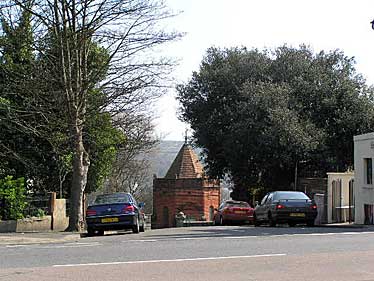
Now a Cul-de-sac called Florence Place
The beginning of the original Hollingdean Road (now a Cul-de-Sac named Florence Place) was at the junction off Ditchling Road (just north of The Downs Infants' School) marked by The Jolly Brewers' Publc House (still present at the corner).
This was a straight route all the way through to Lewes Road.
The Jolly Brewer's Inn is marked under this name on the 1873 map. The occupants of No. 29 Ditchling Road in the 1871 census are publicans - Thomas and Sarah Burtenshaw (head).
The 1878 Post Office Directory gives the name of Henry Geoffrey Scarratt as the next owner. The Jolly Brewer Public House (alternative name) dates back to as early as 1848 (when David Dunk was the proprietor). We learn from Brighton and Hove City Council's listing of The Jolly Brewer as a Heritage asset that Tamplin's acquired the property in 1874. Tamplin's was a well known brewer in Victorian times and their name also appeared on The Victoria Inn (built in the early 1890s) at the junction of Richmond and Mayo Road.
The side by side OS 25 inch 1892-1914 map shows a loop called "Hollingdean Road" in the THEN section on the left, but clarifies that this stretch west of the Victorian railway bridge is called "Upper Hollingdean Road" in the NOW section on the right. Access to this loop, suitable for heavier traffic, begins at the traffic lights further up Ditchling Road. The east end of the original Hollingdean Road, which is now known as Hollingdean Lane, joins Upper Hollingdean Lane just before the Victorian railway bridge. The section between the railway bridge and Lewes Road retains its original name "Hollingdean Road".
The original Hollingdean Road marked the old Brighton Borough / Preston Parish boundary. Preston was a very large parish. Although we associate it with London Road, it stretches as far east as Preston Barracks on Lewes Road.
The edge of town was traditionally the place for burying the dead. The straight line continues up Bear Road, which you can see over the top of the Victorian railway bridge. As well as the Jewish Cemetery where Hollingdean Road used to begin, there are further cemeteries on both sides of Bear Road.
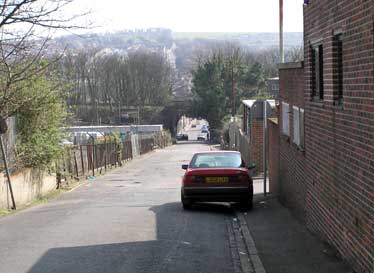
Today called "Hollingdean Lane"
To the right (in the above picture of the former Hollingdean Road) is a site which has had many different uses over time:
- From the 1850s, this was the site of the kennels donated by Thomas Read Kemp to the Union Hunt (Brighton's own hunting Harrier pack which had been relocated several times since 1761 when they were founded). The kennels were still present on the 1873 map, which labels the street as "Hollingdean Road" while still marking the kennels which gave rise to the name "Dog Kennel Road".
- The records at the Keep record a planning proposal for an abattoir (circa 1860) in Dog Kennel Road, though Brighton's Municipal Abattoir did not open on this site until 30 June 1896. No abattoir is shown on the 1873 map. Although opened to help reduce the number of insanitary slaughterhouses, the abattoir was closed in 1986 since it failed to meet stricter health standards (possibly eminating from the EU).
- On 19th June 2006, Veolia was granted planning permission for construction and operation of a Materials Recovery Facility and Waste Transfer Station on the (by then) Hollingdean Lane site.
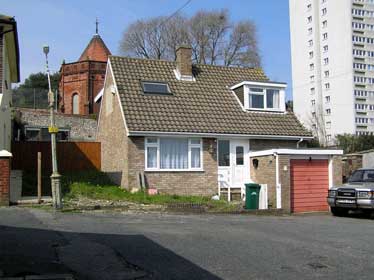
The Jewish Cemetery (from 1826)
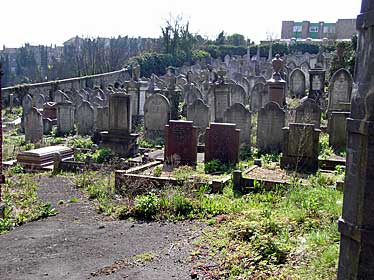
See record at The Keep dated 1826-1897
Deeds of the Jews' Cemetery, Hollingdean Road
(now Hollingdean Lane) and Florence Place, Brighton:
Description: the land for the Hebrew Burial Ground was purchased by Brighton Hebrew Congregation from Thomas Read Kemp on 19 January 1826 for the sum of £100.
An extension to the ground was purchased when Brighton Borough Council stopped up the west end of Hollingdean Road (now Hollingdean Lane).
The newly laid out Upper Hollingdean Road became the through route to Ditchling Road.
A further extension to the south of the burial ground was added in 1897 when Septimus Dixon of Warliegh Lodge, Ditchling Road, sold the congregation a plot measuring 78 feet by 45 feet for £250.
The Ohel (1893)

After the Council stopped off the west end of the original Hollingdean Road, a new zig-zag access was created on the east side of Ditchling Road just north of the railway tunnel mining under wha is now the BP Garage. So the entrance to what became Hollingdean Lane (after Upper Hollingdean Road became the main East -West access) was moved south.
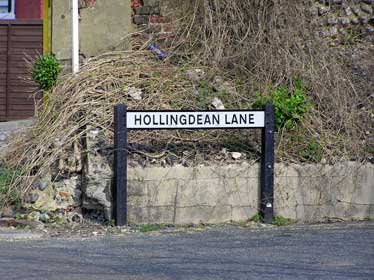
The zig-zag stretch lacks pavements and street lighting so is unfriendly to pedestrians. Also a no-entry prevents vehicles from accessing the zig zag section from the east so there is little or no through traffic.
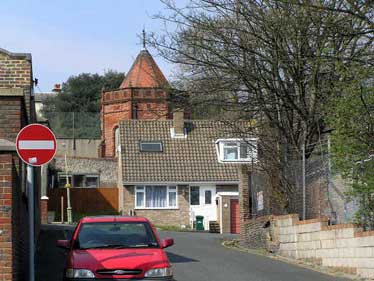
Hollingdean Lane has been used as a private access road for smaller Council vehicles to reach their depots.
When planning permission was given for Veolia's installations, there was both insistence that
- larger Council vehicles (or those belonging to Veolia) should not use this access
- a right of way should remain to allow pedestrians to use the old boundary road to get to the Victorian railway bridge on Hollingdean Road and to reach Lewes Road beyond.
I recall seeing the zig-zag stretch used by dog walkers and small street cleaning vehicles - perhaps a fortunate combination. There are now two houses where the zig zag meets the straight section.
Return to Main History Section.
This page was last updated by Ted on 09-Oct-2025